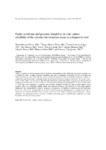Mostrar o rexistro simple do ítem
Frailty syndrome and genomic instability in older adults: suitability of the cytome micronucleus assay as a diagnostic tool
| dc.contributor.author | Sánchez-Flores, María | |
| dc.contributor.author | Marcos-Pérez, Diego | |
| dc.contributor.author | Lorenzo-López, Laura | |
| dc.contributor.author | Maseda, Ana | |
| dc.contributor.author | Millán-Calenti, José Carlos | |
| dc.contributor.author | Bonassi, Stefano | |
| dc.contributor.author | Pásaro, Eduardo | |
| dc.contributor.author | Laffon, Blanca | |
| dc.contributor.author | Valdiglesias, Vanessa | |
| dc.date.accessioned | 2018-07-03T11:28:00Z | |
| dc.date.issued | 2018-01-13 | |
| dc.identifier.citation | Sánchez-Flores M, Marcos-Pérez D, Lorenzo-López L, Maseda A, Millán-Calenti JC, Bonassi S, Pásaro E, Laffon B, Valdiglesias V. Frailty syndrome and genomic instability in older adults: suitability of the cytome micronucleus assay as a diagnostic tool. J Gerontol A Biol Sci Med Sci. 2018 Jun 14;73(7):864-872. | es_ES |
| dc.identifier.issn | 1079-5006 | |
| dc.identifier.issn | 1758-535X | |
| dc.identifier.uri | http://hdl.handle.net/2183/20842 | |
| dc.description.abstract | [Abstract] Frailty, a condition involving increased risk of disability and mortality in older adults, has emerged as a reliable way to predict the effect of aging. Genomic instability may help to anticipate recognition of frail individuals and improving frailty outcomes. Our objective was to evaluate the potential of the micronucleus frequency, evaluated in lymphocytes and buccal cells, to anticipate frailty identification and improve diagnosis reliability. Our results, from a group of older adults over 65, showed that frail individuals had significantly higher frequencies of micronucleus in lymphocytes (19.16 ± 0.66 vs. 13.07 ± 0.78, p < .001) and of binucleated buccal cells (82.65 ± 3.42 vs. 37.16 ± 2.85, p < .001) and lower frequencies of pyknotic and condensed chromatin buccal cells, than nonfrail subjects. When cognitive status was considered, similar results were obtained. Moreover, the presence of frailty and cognitive impairment were independently related to increases in frequencies of lymphocyte micronucleus and binucleated buccal cells. Our results encourage the use of micronucleus frequency in lymphocytes as a complement to clinical parameters in frailty identification. However, these results have to be further evaluated in prefrail patients, to better understand the connection between genomic instability and frailty and to establish these parameters as actual biomarkers of frailty in clinical practice. | es_ES |
| dc.description.sponsorship | Xunta de Galicia; ED431B 2016/013 | es_ES |
| dc.description.sponsorship | Xunta de Galicia; ED431C 2017/49 | es_ES |
| dc.description.sponsorship | Xunta de Galicia; IN607C 2016/08 | es_ES |
| dc.description.sponsorship | Xunta de Galicia; ED481B 2016/190-0 | es_ES |
| dc.description.sponsorship | Italia. Associazione Italiana per la Ricerca sul Cancro; IG17564 | es_ES |
| dc.language.iso | eng | es_ES |
| dc.publisher | Oxford | es_ES |
| dc.relation.uri | https://doi.org/10.1093/gerona/glx258 | es_ES |
| dc.rights | This is a pre-copyedited, author-produced version of an article accepted for publication in "The journals of gerontology. Series A, Biological sciences and medical sciences" following peer review. The version of record is avaliable onliine at Oxford Academic web. | es_ES |
| dc.subject | Buccal cells | es_ES |
| dc.subject | Cognitive status | es_ES |
| dc.subject | Lymphocytes | es_ES |
| dc.title | Frailty syndrome and genomic instability in older adults: suitability of the cytome micronucleus assay as a diagnostic tool | es_ES |
| dc.type | info:eu-repo/semantics/article | es_ES |
| dc.rights.access | info:eu-repo/semantics/embargoedAccess | es_ES |
| dc.date.embargoEndDate | 2019 | es_ES |
| dc.date.embargoLift | 2019-01-13 | |
| UDC.journalTitle | The journals of gerontology. Series A, Biological sciences and medical sciences | es_ES |
| UDC.volume | 73 | es_ES |
| UDC.issue | 7 | es_ES |
| UDC.startPage | 864 | es_ES |
| UDC.endPage | 872 | es_ES |
Ficheiros no ítem
Este ítem aparece na(s) seguinte(s) colección(s)
-
INIBIC-IX - Artigos [31]






